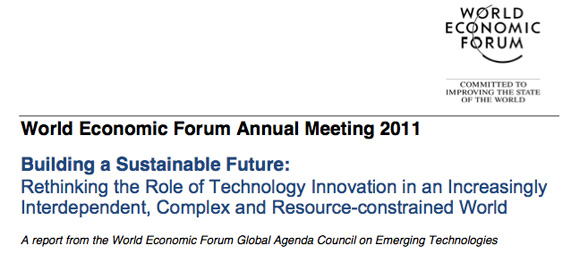“Technology doesn’t just happen” – people must be sick of hearing me say this. Yet as chair of the World Economic Forum Global Agenda Council on Emerging Technologies, it’s something I seem to end up saying rather a lot as we strive to help decision-leaders maximize the benefits of technology innovation, while avoiding untoward consequences.
The trouble is, it’s all too easy for people to assume that technology innovation will provide bolt-on answers to pressing problems as and when they are needed – a potentially dangerous misconception. Which is why the Council has just published a new paper through the World Economic Forum that looks at how we develop and use technology within an increasingly complex and interconnected society, and how we can translate this into developing timely, cost effective and acceptable solutions to pressing global challenges.
Building a Sustainable Future: Rethinking the Role of Technology Innovation in an Increasingly Interdependent, Complex and Resource-constrained World is co-authored by myself and Tim Harper – director of CIENTIFICA Ltd. – and takes a hard look at the increasingly tough task of ensuring technology innovation helps solve the problems we need it to solve as a society, rather than just the ones that are easy to solve.
In it, we recommend that action is needed in seven areas, including increasing access to intelligence on new technologies; building new partnerships and engaging more effectively with stakeholders; re-examining how innovative ideas are translated into effective solutions to pressing problems; and rethinking the process of global technology governance.
Working with my colleagues on the Emerging Technologies Global Agenda Council, I kept coming back to three things in particular as we crafted the paper:
How can we ensure relevant and responsive technology-based solutions to problems are available as and when they are needed? I worry sometimes that focus too much on the successes of technology innovation in helping address issues, and neglect to contemplate our failures. Yet it is where we have failed to cure a disease, or to relieve poverty and hunger, or to increase someone’s quality of life, that we have the most to learn. It’s easy to match a new technology to a pressing need and claim success. It’s much harder to start with a need, and develop technology-based solutions that will help resolve it – especially if timescales are long and profits are potentially marginal. How can we change the paradigm so we start with the problem, not the solution?
How can we proactively invest in technology innovation so that it gets us where we need to be, when we need to be there? I am constantly surprised at the blind faith many people have in science and technology – assuming or hoping that it will deliver just-in-time solutions to just-discovered problems. The reality is that it takes years – decades even – of targeted research and development to arrive at relevant and responsive technology innovations. Which means that in today’s world, we need to become increasingly forward-thinking and integrative in how we craft and implement the science and technology agenda. How can we move away from technology innovation being perceived as an off the shelf solution to problems, and toward it being understood as an integrated part of addressing issues?
How can we avoid new risks from new technologies, while also using them to reduce established and emerging risks? Emerging technologies lead to new potential risks – thousands of years of technology innovation attest to this. As the rate of technology innovation increases and the world becomes increasingly interconnected, we are going to need new ways to respond to these risks if we are to build a sustainable future. Yet there is another side to the innovation-risk equation. Technology innovation also has the potential to provide the means of managing or avoiding old and new risks – but only if it is developed and implemented appropriately. How do we ensure that emerging technologies are an integral part of the toolkit we use to reduce risks, and improve quality of life?
These weren’t the only drivers behind the paper – there were many other issues we grappled with, and high on the agenda was the economic imperative of thinking increasingly smartly about how we develop and use emerging technologies. But the questions surrounding quality of life and risk struck a particular chord with me, having worked at the intersection between emerging technologies, risks and benefits for a number of years.
Next week sees the annual World Economic Forum meeting in Davos. This year the theme is Shared Norms for the New Reality, and is built around four “pillars”: Responding to the New Reality; The Economic Outlook and Defining Policies for Inclusive Growth; Supporting the G20 Agenda; and Building a Risk Response Network.
I will be there, talking to people about the Building a Sustainable Future paper in the context of each of these pillars. But it is that last pillar that I will be focusing on in particular. Sustainability depends on getting smart about identifying, addressing and managing risks – often before they have happened, and this means getting smarter on how we develop and use new technologies. The potential is there to do great things. There’s also the danger of technology innovation increasing the chances of harm if we aren’t careful. The trick will be to learn how to be more sophisticated, integrative and informed in how we develop and use technology innovation. And to ensure we are proactive in planning for a technology-driven future.
Because… technology doesn’t just happen – you know!
_______
The Building a Sustainable Future white paper can be read and downloaded here. Tim and I also gave a guest blog on the paper on the World Economic Forum blog – ForumBlog.org


Very interesting, good luck!
I will try to add this thinking to your thoughts on our DebateGraph Emerging Technology Governance map, they provide a rich source of debate for our Group, thanks again! Please feel free to point anyone to it http://debategraph.org/MATTER.